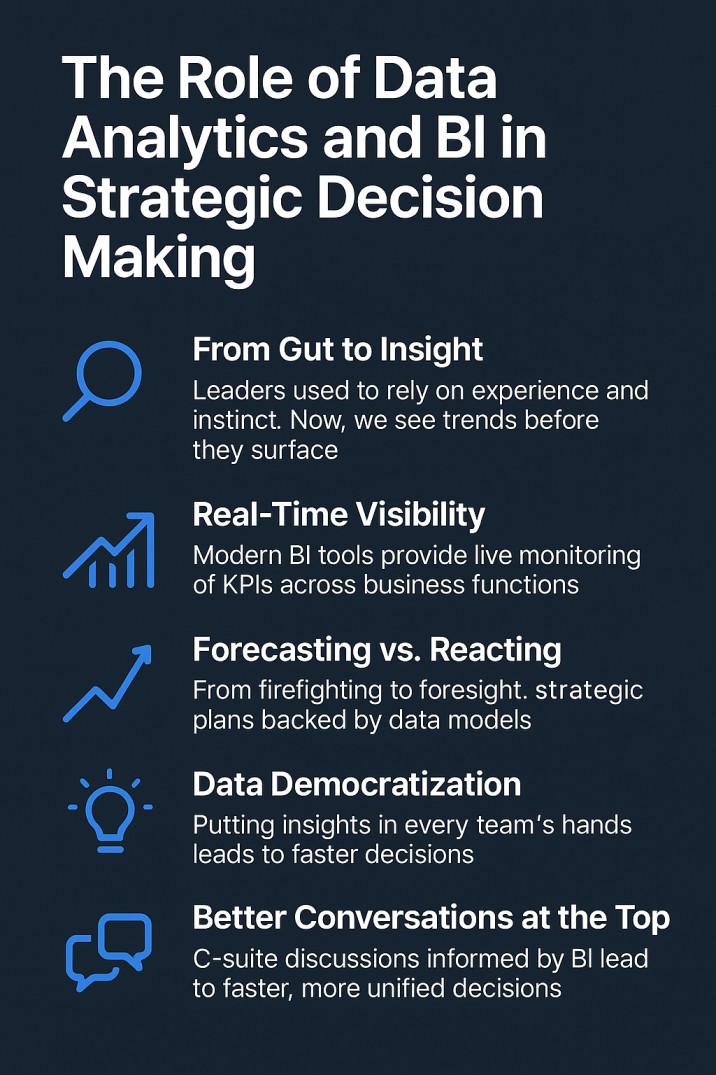A personal perspective from years in digital transformation projects
In today’s digital economy, decisions made without data are no longer strategic — they’re risky.
Having led and advised several digital transformation projects across industries, I’ve seen one pattern emerge consistently: organizations that embed analytics and business intelligence (BI) into their core decision-making process move faster, adapt better, and scale smarter.
While technologies like AI, cloud, and automation get most of the spotlight, data analytics and BI are the foundation that silently powers confident and contextual decisions.
Let’s explore why these tools are not just helpful but absolutely essential.
From Gut to Insight
For decades, businesses relied on instinct, legacy experience, and anecdotal wisdom. That worked — until the world became too complex and fast-moving for intuition alone.
Today, the cost of being wrong is higher, and the margin for trial-and-error has shrunk. What changed the game for me and many of the clients I’ve worked with was the transition from opinion-based to evidence-based decision-making.
Whether it’s entering a new market, changing a product strategy, or reallocating budgets, data gives you visibility into what’s working and what’s not — backed by facts, not assumptions.
It’s not about replacing experience, but enhancing it with context.
Real-Time Visibility
One of the most tangible benefits of modern BI platforms is their ability to turn real-time operational data into digestible dashboards.
In one engagement, a retail chain used BI to monitor sales, inventory, and customer behavior across hundreds of stores in real time. The leadership team no longer waited for weekly reports — they could make decisions daily, even hourly.
This shift to real-time visibility means that every department — from finance to customer service — can act faster, resolve bottlenecks quickly, and stay aligned on key metrics.
When everyone sees the same data, the business moves in sync.
Forecasting Over Reacting
Being data-driven isn’t just about reporting the past — it’s about anticipating what’s next.
With predictive models and historical patterns, organizations can move from reacting to problems to proactively addressing them. I’ve seen logistics companies reduce delivery failures through demand forecasting, and SaaS businesses reduce churn by identifying early risk signals.
Forecasting enables scenario planning, letting leaders simulate “what if” questions before making high-impact decisions.
It’s not about eliminating uncertainty — it’s about navigating it with foresight.
Empowering Every Team
One of the major shifts in BI adoption is the move from centralized, analyst-only tools to self-service platforms.
This democratization means that product managers, marketing leads, HR heads, and even front-line supervisors can access the insights they need without waiting days or weeks.
I’ve worked on implementations where giving managers access to real-time metrics directly influenced faster hiring decisions, optimized campaign strategies, and even improved employee retention.
When everyone has access to data, everyone can lead smarter.
Smarter Executive Conversations
At the leadership level, BI creates alignment and reduces friction.
Instead of debating whose spreadsheet is accurate, C-level leaders can view a shared, consistent source of truth. This changes the nature of strategic discussions — they become focused on action, not interpretation.
In boardrooms, I’ve witnessed decisions that would take weeks get finalized in one session — all because the data was clear, traceable, and aligned to goals.
BI fosters clarity. Clarity drives confidence. Confidence enables execution.
Final Thoughts: Data Isn’t a Tool — It’s a Mindse
Too often, analytics is seen as a backend support function. In reality, it should be central to your business architecture and leadership culture.
Whether you’re a startup founder, a transformation consultant, or an enterprise leader, one truth remains: your competitive edge lies in how well your decisions are informed by data.
If data doesn’t drive your decisions, your competition’s will.
So ask yourself:
- Are your teams aligned around a shared set of metrics?
- Can you see your KPIs in real time?
- Is your strategy shaped by trends, forecasts, and data-backed insight?
If the answer is no — it’s time to make analytics and BI a first-class citizen in your digital transformation journey.
I’d love to hear how your organization is using data today. Are you still building toward it, or already data-driven? Let’s start a conversation.

